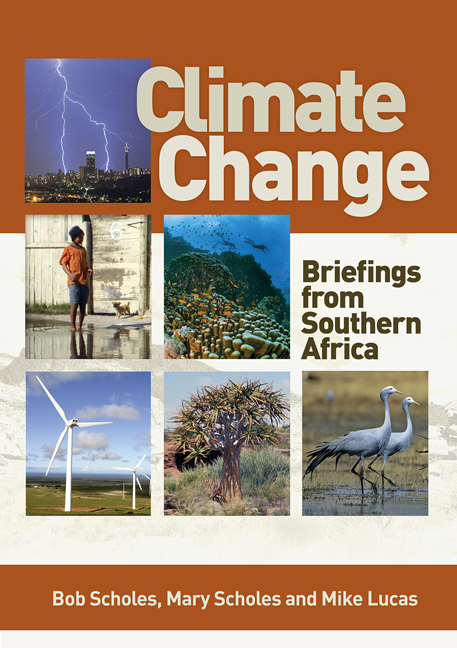Book contents
- Frontmatter
- Acknowledgements
- Contents
- Foreword
- Acronyms and abbreviations
- Preface
- How do governments assess climate change?
- Section 1 Earth system science: The processes that underlie climate change
- Section 2 Consequences of a changing climate for the Southern African environment
- Introduction
- 1 How resilient are ecosystems to climate change?
- 2 How will South Africa's plants respond to climate change?
- 3 Could rising carbon dioxide concentrations boost plant growth?
- 4 Is bush encroachment caused by global change?
- 5 Will South Africa's land animals cope with climate change?
- 6 Are South Africa's birds taking flight?
- 7 Will South Africa run out of water?
- 8 How will climate change affect freshwater ecosystems?
- 9 How much, and how fast, will sea level rise?
- 10 What is ocean acidification?
- 11 How will ocean acidification affect marine organisms?
- 12 How is climate change affecting South Africa's coastal seas?
- 13 How is our marine life responding to climate change?
- 14 Will coral reefs survive climate change?
- 15 Are South Africa's Prince Edward Islands vulnerable to climate change?
- 16 How are Antarctica and the Southern Ocean responding to climate change?
- Section 3 Consequences of a changing climate for society
- Section 4 What we can do to avoid and adapt to climate change
- Codicil Is there a dangerous level of climate change?
- Glossary
- List of figures
- References
- Reading list
- Index
1 - How resilient are ecosystems to climate change?
from Section 2 - Consequences of a changing climate for the Southern African environment
Published online by Cambridge University Press: 20 April 2018
- Frontmatter
- Acknowledgements
- Contents
- Foreword
- Acronyms and abbreviations
- Preface
- How do governments assess climate change?
- Section 1 Earth system science: The processes that underlie climate change
- Section 2 Consequences of a changing climate for the Southern African environment
- Introduction
- 1 How resilient are ecosystems to climate change?
- 2 How will South Africa's plants respond to climate change?
- 3 Could rising carbon dioxide concentrations boost plant growth?
- 4 Is bush encroachment caused by global change?
- 5 Will South Africa's land animals cope with climate change?
- 6 Are South Africa's birds taking flight?
- 7 Will South Africa run out of water?
- 8 How will climate change affect freshwater ecosystems?
- 9 How much, and how fast, will sea level rise?
- 10 What is ocean acidification?
- 11 How will ocean acidification affect marine organisms?
- 12 How is climate change affecting South Africa's coastal seas?
- 13 How is our marine life responding to climate change?
- 14 Will coral reefs survive climate change?
- 15 Are South Africa's Prince Edward Islands vulnerable to climate change?
- 16 How are Antarctica and the Southern Ocean responding to climate change?
- Section 3 Consequences of a changing climate for society
- Section 4 What we can do to avoid and adapt to climate change
- Codicil Is there a dangerous level of climate change?
- Glossary
- List of figures
- References
- Reading list
- Index
Summary
The species that make up any given ecosystem will alter under the anticipated rate and degree of climate change, but the functioning of the ecosystem itself will generally be more resilient.
Resilience is the capacity of a system to tolerate a disturbance without losing its essential functions. Of course, there is no such thing as guaranteed resilience to all possible disturbances. It is therefore meaningless to consider an ecosystem as being generally resilient or fragile, without considering what specific threat is being faced. So let's consider the resilience of two ecosystem properties – composition (the relative abundance of species in the ecosystem) and function (for instance, the process of primary production) – in response to a temperature rise of 3°C over 100 years. This temperature change scenario is quite plausible during this century.
Plant and animal populations around the world have repeatedly experienced a 3°C or larger change over the past few million years. The difference in temperature between past ice ages and intervening warm periods was around 5°C. The change occurred gradually, over thousands of years (see Sec. 1, Q5). Certainly there were local and even global species losses associated with the advance and retreat of the ice ages but, overall, ecosystems seem to have maintained their ability to function, regenerate and rebuild their diversity in a different way. This change was also slow enough to allow species to migrate to new habitats if necessary.
The rate of past climate change was about 100 times slower than the current human-caused changes. Rapid change overwhelms the ability of many organisms to respond by adaption or migration, which they could do if the pace of change was slower. On land, for many species the migration option is now compromised by the conversion of a quarter of Earth's surface to cropland, roads and urban sprawl. Furthermore, most ecosystems are faced with multiple and simultaneous stressors acting in addition to climate change, such as overharvesting, pollution and invasive alien species. It is therefore little wonder that, as many ecosystems adjust, they are projected to lose a large fraction of their species. Species with narrow climate tolerances, small populations and limited migration capacity will be most affected. In South Africa this means that the fynbos, succulent Karoo and grasslands are more vulnerable than, for instance, the savannas.
- Type
- Chapter
- Information
- Climate ChangeBriefings from Southern Africa, pp. 53 - 55Publisher: Wits University PressPrint publication year: 2015



